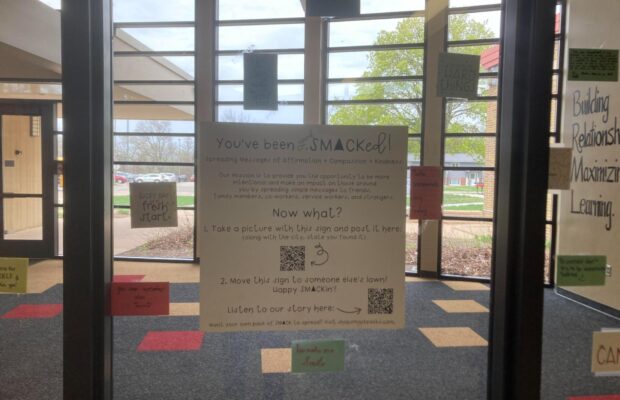Students, faculty debate direction for next year’s homeroom
By Sheila Moussavi 2007
When it comes to new school programs, few could be as unexpectedly and unintentionally controversial as the homerooms established earlier this year.
This program, proposed by English teacher Dianne Flaherty and facilitated by a homeroom committee consisting of several CFHS faculty members and administrators, was created originally to enhance community within the school.
“It was made to build two of the 4-Rs (Relationships and Reflection—the other two are Relevance and Rigor) and to provide each student with an adult they can communicate with at the school,” Flaherty said.
In order to achieve this goal, the alphabetically assigned homerooms meet for 20 minutes every Wednesday to participate in discussions and various activities.
While most students accurately recognize the goal of homerooms, the effectiveness of the program has proved far more debatable. Equally controversial has been whether homerooms are actually necessary at Cedar Falls High School and what program changes may or may not be in order.
Most students seem to agree with senior Joey Squires that, in its present state, “it’s just an ineffective strategy to fix a nonexistent problem. Do students really know each other better? Do they really get along with their teacher better? Do they really have an adult advocate?”
Senior Sarah Pattee agreed. “I don’t think the curriculum has been uniform for everyone because there hasn’t been a collaborative effort. It isn’t taken seriously enough to be effective.”
For students like Squires and Pattee, the point of homeroom may be evident enough, but the proof of its effectiveness has yet to be seen or experienced.
Despite these concerns, there is plenty of optimism about the program’s future. While the benefits of homeroom have been slow in their development, many students, like senior Alex Ulfers, attribute the current turbulence to the natural pattern of a program in transition.
As he said, “The program involves change, and we, as seniors, do not like change.”
Senior Stephen Miller agreed that time is a necessary element in establishing an effective program: “Right now, teachers and students don’t know exactly what to do, but once the younger kids reach this stage, they’ll be used to the program.”
Though many students consider the potential benefits worth waiting for, others consider this optimism unjustified. Sophomore Amelia Gotera has a more fundamental complaint against the homeroom program. “Forced bonding never really has a positive effect,” she said. “Relationships are based on common interests, and you can’t really force people to open up and become comfortable with each other.”
The argument only leads, however, to yet another debate. Assuming the general optimism proves correct and homerooms eventually accomplish their goal, does it justify the time lost from class every Wednesday? This currently hypothetical but still relevant question has stirred endorsement from some, criticism from others.
To some, homeroom at its (theoretical) best would certainly compensate for lost time in scheduled classes. Senior Nicky Newhoff is among the supporters. She said, “If it works out, homeroom would be worth the lost time in class because it would help students gain more friends than they would in a silent classroom with only the teacher talking.” These students would argue that the overriding benefits to the sense of community would outweigh the slight educational sacrifice.
Others counter that nothing, least of all a program that they characterize as so completely devoid of educational value, could justify the commitment of time. As Squires said, “We’re already falling behind the rest of the world in education, and we cannot afford to waste time on programs that have absolutely nothing to do with the original purpose of school.”
Junior Mark Iehl has a similar complaint: “The primary function of school is to provide students with an education that will prepare them for college and, more importantly, the real world. I do not think homeroom does either of these.” To Iehl, the value of homeroom cannot outweigh the commitment of time.
Unfortunately for any dissenting students, this is practically a moot point. As it turns out, there is absolutely no momentum among the deciding party to end homerooms altogether. CFHS Principal Rich Powers said, “Two things are certain at this point: homeroom is definitely not going to be removed and certain changes do need to be made.”
According to Powers, the exact nature of the changes is still uncertain at this point and depends largely on suggestions by faculty and students.
So what suggestions have students offered?
Many find argument with the way homerooms are divided. Right now, students are assigned by last name, which many find too random to be effective.
“There is no relevant pattern to this organization,” Miller said. “Some other criteria besides last name should be considered.” Newhoff offered one idea. She said, “Homerooms could be split between boys and girls,” she suggested. “That would make it more comfortable for everyone.
Other ideas involved the content of each session. “I would start the year with interactive activities, like ice-breakers, to establish trust and unity if you want students to open up,” Pattee said.
She added, “I think community service projects are also good activities because they bring a sense of pride and get students interacting together.”
Senior Brittany Naylor had a more general suggestion: “Make the time useful—assign activities that aren’t going to just fill time.”
As students and faculty explore every aspect of homerooms, steps are being taken to create a lasting, effective plan. According to plan, the program’s future will be decided by the fall of next year.








You must be logged in to post a comment Login